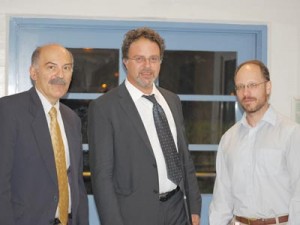Armen Arikian
Staff Writer

Photo: Erica Magarian
Dr. Sebouh Aslanian, newly appointed Richard Hovannisian Professor of Modern History at UCLA, was invited to speak at Fresno State on “From the Indian Ocean to the Mediterranean: The Global Trade Networks of Armenian Merchants from New Julfa” on Friday, October 21, as part of the Armenian Studies Program Fall Lecture series.
Dr. Aslanian came with the purpose of sharing his knowledge and expertise of New Julfan history with the Fresno Armenian community. Dr. Aslanian is a historian who has traveled across the world in search of new information to add to his discoveries about the New Julfan community. He has visited several archives, uncovering new documents on the history of that community. There are very few economic studies on the New Julfan market system, but Dr. Aslanian’s research has revealed many details of the community that were previously unknown.
Old Julfa was an Armenian-inhabited mercantile town in the Ottoman Turkish Empire. In the midst of a war between the Ottoman Turks and Safavid Persians in 1604-1605, Shah Abbas I of the Safavid Empire forcibly deported the Armenian population of Julfa and surrounding regions to his capital city of Isfahan. He then assigned one quarter of the capital to the Armenians, which came to be known as “New Julfa.”
Shah Abbas granted special privileges to the New Julfans, who soon prospered as merchants and businessmen. Dr. Aslanian discussed the background of New Julfa and how the community came to be of such economic and historic importance.
The New Julfans played a crucial role in the world’s economy, especially in the silk trade. They became noted for developing one of the most advanced trading systems in the world. New Julfan trade spread across three neighboring empires: the Mughal (India), the Safavid, and the Ottoman.
The Indian Ocean network connected New Julfa with various regions, and New Julfan agents would travel by ship across the Indian Ocean to reach their destinations. Dr. Aslanian explained how the New Julfans experienced difficulties with maintaining this network, which relied heavily on wind patterns and the ocean currents. The two primary wind patterns of Indian Ocean are Northwest and Southwest: Northwestern wind currents took place from December to March whereas Southwestern wind currents took place from May to October. If the New Julfans spent too much time at their destination, they would be unable to return to New Julfa until the wind pattern changed.
The New Julfans maintained a system where they traded with people who they could trust. Dr. Aslanian emphasized this trust as he described a process used amongst Julfans for trade. Commenda contracts, a primary example of this mutual trust, served as a foundation of New Julfan trade. This type of agreement was between two New Julfans, one a merchant capitalist, and the other an agent, who would represent the merchant.
The agent would normally be away from home several years at a time conducting business for the merchant. Upon the agent’s return, earnings were divided, with the hard working agent receiving a mere 25 percent of the profit, while the merchant received 75 percent. Dr. Aslanian used the Commenda contract to illustrate the theme of trust among the New Julfan community. Why would an agent agree to perform a majority of the labor for minimal profit? The reason is so that they could build a strong reputation within the region. Trust was essential in the New Julfan community.
The New Julfan community remained vibrant and successful for a little more than one hundred years. Several Armenian churches remain standing in the region, serving as a reminder of one of the most successful mercantile systems in the world.
 Hye Sharzhoom Armenian Action
Hye Sharzhoom Armenian Action